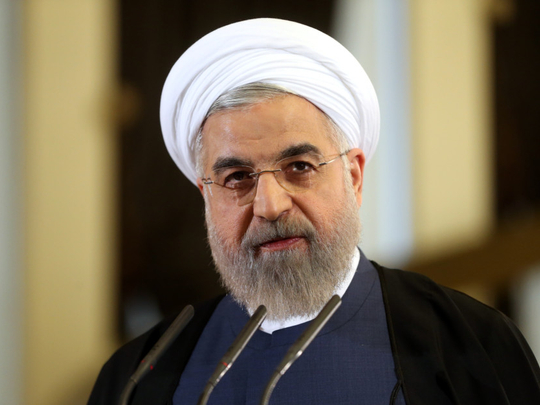
US President Barack Obama and Iranian President Hassan Rouhani say they have achieved separate major goals in the framework agreement among the US, the five other world powers and Iran regarding Tehran’s nuclear programme. Obama, last Thursday, declared that “the United States, together with our allies and partners, have reached a historic understanding with Iran, which, if fully implemented, will prevent it from obtaining a nuclear weapon”.
Last Friday, Rouhani announced in a radio address to his nation: “We have both maintenance of nuclear rights and removal of sanctions, alongside constructive interaction with the world” — elements that were central to his presidential campaign in 2013.
As with all such agreements, the devil will be in the details, which remain to be worked out before a June 30 deadline. Meanwhile, critics and doubters in Washington, occupied Jerusalem and elsewhere will be pointing out gaps and weaknesses that need to be remedied before a final Comprehensive Plan of Joint Action can be completed and signed by the participating countries.
Pause for a moment and recall that just two years ago, the talk was mostly about military action. Israeli Prime Minister Benjamin Netanyahu said that sanctions were not working and Israeli Defence Minister Ehud Barak, during a visit to Washington, said: “All options must remain on the table,” — meaning, a military attack — and “we expect all those who say it to mean it. We mean it.”
In Israel on March 20, 2013, Obama listened during a joint news conference as Netanyahu said: “Diplomacy and sanctions must be augmented by a clear and credible threat of military action.” Obama responded, “The United States will continue to consult closely with Israel on next steps and I will repeat: All options are on the table.” That was taken to mean that if diplomacy failed, a military attack could be necessary.
On May 22, 2013, the US Senate passed a resolution, 99 to 0, that said if Israel took “military action in self-defence against Iran’s nuclear weapons programme”, the US “should provide Israel with diplomatic, military and economic support”. It added, though, “that nothing in this resolution shall be construed as an authorisation for (America’s) use of force or a declaration of war”.
In Iran, there was a strong reaction to the talk of military action. Supreme Leader Ayatollah Ali Khamenei had threatened in a March 2013 televised speech that in response to any Israeli strike, “the Islamic republic will annihilate Tel Aviv and Haifa to the ground”. On April 8, 2013, the then-Iranian President Mahmoud Ahmadinejad announced he was expanding uranium production, rejecting a suggestion from the P5+1 (US, China, Russia, Britain, France plus Germany) that Iran reduce the amount of uranium enriched to 20 per cent that it already had processed.
The atmosphere changed with Rouhani’s election. Increased diplomacy culminated in the November 24, 2013, Geneva agreement that temporarily froze Iran’s programme and committed Tehran to eliminate its stockpile of uranium enriched to 20 per cent. In return, the P5+1 countries agreed to release $4.2 billion (Dh15.44 billion) in frozen Iranian assets and provide relief from a handful of minor sanctions.
It also set the stage for the negotiations that led to last Friday’s framework agreement.
Now, we have a verbal war — much better than a military one — over what has been agreed to, with each side aiming to counter critics.
Two items in the framework agreement — timing for removal of sanctions and the handling of inspections — appear to get different treatment in separate fact sheets released by the US and Iran. Obama and the US Secretary of State, John Kerry, have emphasised that there will a step-by-step easing of sanctions as Iran “verifiably abides by its commitments”, according to the US fact sheet. For example, the US fact sheet says all past United Nations sanctions “will be lifted simultaneously with the completion by Iran of all key concerns”. Each of those elements could take months or perhaps years to implement.
The Iranian fact sheet is ambiguous about the removal of sanctions, which, for Iranians, is a key benefit. It states, in bold text in an early paragraph, that “all of the sanctions will be immediately removed after reaching a comprehensive agreement”. But in the next sentence, it says that “after the implementation of the Comprehensive Plan of Joint Action” the multilateral and US unilateral economic and financial sanctions will “be annulled”.
Depending on what is meant by “implementation”, that could align it with the US fact sheet.
Adding to the timing ambiguity on the Iranian fact sheet is that it says all sanctions “will be annulled on a single specified day” after a preparatory phase, during which, the UN Security Council will pass a resolution adopting the Joint Action Plan and Iran’s “nuclear-related implementation work” has started.
Another area requiring some clarity is how inspections will be carried out. The US fact sheet says inspectors from the International Atomic Energy Agency will have access to all Iranian nuclear facilities and “suspicious sites” and can investigate “allegations of covert” sites anywhere in the country. It concedes, though, that “a dispute resolution process will be specified”, but how that will work remains to be determined. The Iranian fact sheet says only that alleged violations will be handled by “predetermined mechanisms of response”.
— Washington Post












